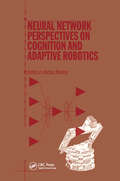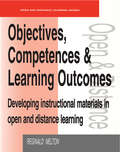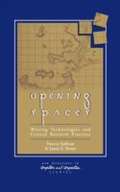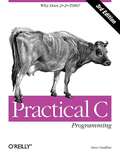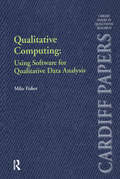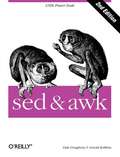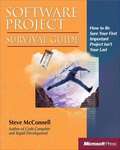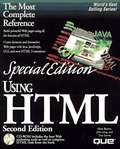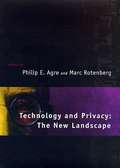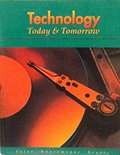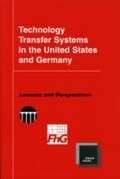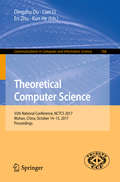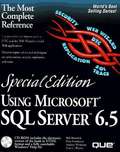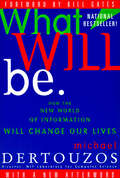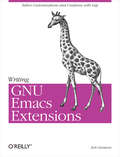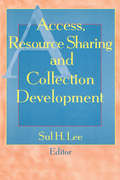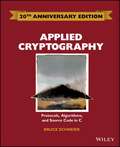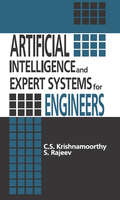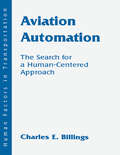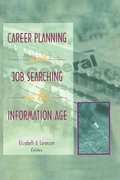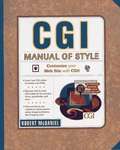- Table View
- List View
Neural Network Perspectives on Cognition and Adaptive Robotics
by A. BrowneFeaturing an international team of authors, Neural Network Perspectives on Cognition and Adaptive Robotics presents several approaches to the modeling of human cognition and language using neural computing techniques. It also describes how adaptive robotic systems can be produced using neural network architectures. Covering a wide range of mainstream area and trends, each chapter provides the latest information from a different perspective.
Objectives, Competencies and Learning Outcomes: Developing Instructional Materials in Open and Distance Learning (Open and Flexible Learning Series)
by Reginald MeltonThis text offers a perspective on issues surrounding student learning by addresssing questions of quality and learning effectiveness across a broad and diverse range of courses, student populations and contexts.
Opening Spaces: Writing Technologies and Critical Research Practices
by Patricia Sullivan James E. PorterThis book argues for a "post critical research methodology" and applies this frame to the study of computers and writing: the book opens a space where theoretical scholarship and empirical research can interact.
Practical C Programming, 3rd Edition
by Steve OuallinePractical C Programming teaches you not only the mechanics of programming, but also how to create programs that are easy to read, maintain, and debug. This third edition introduces popular Integrated Development Environments on Windows systems, as well as UNIX programming utilities, and features a large statistics-generating program to pull together the concepts and features in the language.
Qualitative Computing: Using Software for Qualitative Data Analysis (Cardiff Papers in Qualitative Research)
by Mike FisherAs qualitative researchers incorporate computer assistance into their analytic approaches, important questions arise about the adoption of new technology. Is it worth learning computer-assisted methods? Will the pay-off be sufficient to justify the investment? Which programs are worth learning? What are the effects on the analysis process? This book complements the existing literature by giving a detailed account of the use of four major programs in analyzing the same data. Priority is given to the tasks of qualitative analysis rather than to program capability and the programs are treated as tools rather than as a discipline to be acquired. The key is not what the programs allow researcher to do, but whether the tasks that researchers need to undertake are facilitated by the software. Thus the study develops a user-centred approach to the adoption of computer-assisted qualitative data analysis. The author emphasises qualitative analysis as a creative craft, but one which must increasingly be subject to rigorous methodological scrutiny. The adoption of computer-aided methods offers opportunities, but also dangers and ultimately this book is about the scientific qualitative research. Written in a distinctive and succinct style, this book will be valuable to social science researchers and students interested in qualitative research and in the potential for computer-assisted analysis.
sed & awk, Second Edition
by Dale Dougherty Arnold Robbinssed & awk describes two text manipulation programs that are mainstays of the UNIX programmer's toolbox. This edition covers the sed and awk programs as they are mandated by the POSIX standard and includes discussion of the GNU versions of these programs.
Software Project Survival Guide
by Steve Mcconnell<div xmlns="http://www.w3.org/1999/xhtml"><p>This is the field guide for everyone involved in software development--especially those without formal management training. Acclaimed expert Steve McConnell maps out a proven approach to project management</p></div>
Special Edition Using Html, Second Edition
by Mark Brown John JungFeaturing comprehensive, up-to-date instruction on HTML, web page creation, and new programming techniques and technologies, a book and software package covers graphics, style sheets, form layout and design, and creating Java applets.
Technology and Privacy: The New Landscape
by Philip E. Agre Marc RotenbergPrivacy is the capacity to negotiate social relationships by controlling access to personal information. As laws, policies, and technological design increasingly structure people's relationships with social institutions, individual privacy faces new threats and new opportunities. Over the last several years, the realm of technology and privacy has been transformed, creating a landscape that is both dangerous and encouraging. Significant changes include large increases in communications bandwidths; the widespread adoption of computer networking and public-key cryptography; mathematical innovations that promise a vast family of protocols for protecting identity in complex transactions; new digital media that support a wide range of social relationships; a new generation of technologically sophisticated privacy activists; a massive body of practical experience in the development and application of data-protection laws; and the rapid globalization of manufacturing, culture, and policy making. The essays in this book provide a new conceptual framework for the analysis and debate of privacy policy and for the design and development of information systems. The authors are international experts in the technical, economic, and political aspects of privacy; the book's strength is its synthesis of the three. The book provides equally strong analyses of privacy issues in the United States, Canada, and Europe. Contributors: Philip E. Agre, Victoria Bellotti, Colin J. Bennett, Herbert Burkert, Simon G. Davies, David H. Flaherty, Robert Gellman, Viktor Mayer-Schouml;nberger, David J. Phillips, Rohan Samarajiva.
Technology Today & Tomorrow (3rd Edition)
by James F. Fales Vincent F. Kuetemeyer Sharon BrusicTeaches you about the numerous advances being made in the different areas of technology.
Technology Today & Tomorrow (Third Edition)
by James F. Fales Vincent F. Kuetemeyer Sharon BrusicTeaches you about the numerous advances being made in the different areas of technology.
Technology Transfer Systems in the United States and Germany: Lessons and Perspectives
by H. Norman Abramson Jose Encarnacao Proctor P. Reid Ulrich SchmochThis book explores major similarities and differences in the structure, conduct, and performance of the national technology transfer systems of Germany and the United States. It maps the technology transfer landscape in each country in detail, uses case studies to examine the dynamics of technology transfer in four major technology areas, and identifies areas and opportunities for further mutual learning between the two national systems.
Theoretical Computer Science
by Dingzhu Du Lian Li En Zhu Kun HeThe satisfiability (SAT) problem is central in mathematical logic, computing theory, and many industrial applications. There has been a strong relationship between the theory, the algorithms, and the applications of the SAT problem. This book aims to bring together work by the best theorists, algorithmists, and practitioners working on the SAT problem and on industrial applications, as well as to enhance the interaction between the three research groups. The book features the application of theoretical/algorithmic results to practical problems and presents practical problems for theoretical/algorithmic study. Major topics covered in the book include practical and industrial SAT problems and benchmarks, significant case studies and applications of the SAT problem and SAT algorithms, new algorithms and improved techniques for satisfiability testing, specific data structures and implementation details of the SAT algorithms, and the theoretical study of the SAT problem and SAT algorithms. It features: a comprehensive review of SAT research work over the past 25 years; the most recent research results; and a spectrum of algorithmic issues and applications.
The Unpredictable Certainty: Information Infrastructure Through 2000
by NII 2000 Steering CommitteeWe have available an impressive array of information technology. We can transmit literature, movies, music, and talk. Government, businesses, and individuals are eager to go on-line to buy, sell, teach, learn, and more. How, then, should we go about developing an infrastructure for on- line communication among everyone everywhere? The Unpredictable Certainty explores the national information infrastructure (NII) as the collection of all public and private information services. But how and when will the NII become a reality? How will more and better services reach the home, small businesses, and remote locations? The Unpredictable Certainty examines who will finance the NII, exploring how technology companies decide to invest in deployment and the the vain search for "killer apps" (applications that drive markets). It discusses who will pay for ongoing services and how they will pay, looking at past cost/price models relevant to the future. The Unpredictable Certainty discusses the underlying technologies, appliances, and services needed before the NII becomes a reality; reviews key features of important technologies; and analyzes current levels of deployment in telephone, cable and broadcast television, and wireless systems, and the difficulties in interconnection. The volume explores the challenge of open interfaces that stimulate new applications but also facilitate competition, the trend toward the separation of infrastructure from specific services, the tension between mature services and new contenders, the growth of the Internet, and more. The roles governments at different levels might play in fostering NII deployment are outlined, including R&D and the use of information infrastructure for better delivery of government services and information.
Using MS SQL Server 6.5, Special Edition
by Bob Branchek Steve Wynkoop Peter HazlehurstThis book provides a hands-on approach that covers all aspects of working with SQL Servers must-have resource for serious database users!
The Wave Three Way To Building Your Downline
by Richard PoeThe face of home business has changed in recent years. People are building businesses based on good products, treating each other well, and using the power of internet technology. Now millions of people just like you are learning to make a living from home. In this book you'll find dozens of stories of people from soccer moms to beach bums and fortune 500 executives and how they learned to make a living from home. They show you how you can too.
What Will Be: How the New World of Information Will Change Our Lives
by Michael L. DertouzosMichael Dertouzos has been an insightful commentator and an active participant in the creation of the Information Age.Now, in What Will Be, he offers a thought-provoking and entertaining vision of the world of the next decade -- and of the next century. Dertouzos examines the impact that the following new technologies and challenges will have on our lives as the Information Revolution progresses:all the music, film and text ever produced will be available on-demand in our own homesyour "bodynet" will let you make phone calls, check email and pay bills as you walk down the streetadvances in telecommunication will radically alter the role of face-to-face contact in our livesglobal disparities in infrastructure will widen the gap between rich and poorsurgical mini-robots and online care will change the practice of medicine as we know it. Detailed, accessible and visionary, What Will Be  is essential for Information Age revolutionaries and technological neophytes alike.
Writing GNU Emacs Extensions
by Bob Glickstein<p>This book introduces Emacs Lisp and tells you how to make the editor do whatever you want, whether it's altering the way text scrolls or inventing a whole new "major mode." Topics progress from simple to complex, from lists, symbols, and keyboard commands to syntax tables, macro templates, and error recovery.</p>
Access, Resource Sharing and Collection Development
by Sul H LeeAccess, Resource Sharing, and Collection Development explores the role of libraries in acquiring, storing, and disseminating information in different formats to help you better use technology to share scarce resources and connect library users with collections. With an expressed goal of encouraging continued debate and further investigation, this book provides you with developing strategies and procedures to meet the challenges you face as a collection development librarian during this dynamic time. Among the vital concerns addressed are the competition for limited resources, trends in document delivery, the evaluation of document delivery products, and libraries’options for the future.The chapters collected in Access, Resource Sharing, and Collection Development represent the proceedings of the annual conference held by the University of Oklahoma Libraries and the University of Oklahoma Foundation. The book provides insight into your peers’findings and ideas on: access vs. ownership the future role of the bibliographer changes in collection management managing restrained resource budgets an emphasis on the library user as customer the growth and acceptance of document delivery as a component of collection development and ILL electronic publishing and copyright issues commercial document delivery services Access, Resource Sharing, and Collection Development also shows you how to discover and evaluate "free" resources on the Internet, as standards for production, promotion, and maintenance are nonexistent. The challenge of using these materials is being met by developing criteria for selection, looking at cataloging options, and working in cooperation with other institutions. You’ll also learn the different options for document delivery and how to evaluate document delivery products. Among the book’s advice: you should consider the types of document delivery available, examine the benefits of combining outside services with in-house systems, review the criteria for selecting technologies and suppliers, and explore examples of institutions creating customized systems.
Artificial Intelligence and Expert Systems for Engineers (New Directions in Civil Engineering #11)
by C. S. Krishnamoorthy S. RajeevThis book provides a comprehensive presentation of artificial intelligence (AI) methodologies and tools valuable for solving a wide spectrum of engineering problems. What's more, it offers these AI tools on an accompanying disk with easy-to-use software. Artificial Intelligence and Expert Systems for Engineers details the AI-based methodologies known as: Knowledge-Based Expert Systems (KBES); Design Synthesis; Design Critiquing; and Case-Based Reasoning. KBES are the most popular AI-based tools and have been successfully applied to planning, diagnosis, classification, monitoring, and design problems. Case studies are provided with problems in engineering design for better understanding of the problem-solving models using the four methodologies in an integrated software environment. Throughout the book, examples are given so that students and engineers can acquire skills in the use of AI-based methodologies for application to practical problems ranging from diagnosis to planning, design, and construction and manufacturing in various disciplines of engineering.Artificial Intelligence and Expert Systems for Engineers is a must-have reference for students, teachers, research scholars, and professionals working in the area of civil engineering design in particular and engineering design in general.
Aviation Automation: The Search for A Human-centered Approach (Human Factors in Transportation)
by Charles E. BillingsThe advent of very compact, very powerful digital computers has made it possible to automate a great many processes that formerly required large, complex machinery. Digital computers have made possible revolutionary changes in industry, commerce, and transportation. This book, an expansion and revision of the author's earlier technical papers on this subject, describes the development of automation in aircraft and in the aviation system, its likely evolution in the future, and the effects that these technologies have had -- and will have -- on the human operators and managers of the system. It suggests concepts that may be able to enhance human-machine relationships in future systems. The author focuses on the ability of human operators to work cooperatively with the constellation of machines they command and control, because it is the interactions among these system elements that result in the system's success or failure, whether in aviation or elsewhere. Aviation automation has provided great social and technological benefits, but these benefits have not come without cost. In recent years, new problems in aircraft have emerged due to failures in the human-machine relationship. These incidents and accidents have motivated this inquiry into aviation automation. Similar problems in the air traffic management system are predicted as it becomes more fully automated. In particular, incidents and accidents have occurred which suggest that the principle problems with today's aviation automation are associated with its complexity, coupling, autonomy, and opacity. These problems are not unique to aviation; they exist in other highly dynamic domains as well. The author suggests that a different approach to automation -- called "human-centered automation" -- offers potential benefits for system performance by enabling a more cooperative human-machine relationship in the control and management of aircraft and air traffic.
Career Planning and Job Searching in the Information Age
by Elizabeth A. LorenzenCareer Planning and Job Searching in the Information Age answers key questions for today?s providers of career-planning and job-searching information. Librarians and career development professionals’concerns--such as cost-effective use of the Internet, the reliability and integrity of electronic resources, and successful search strategies--are addressed in this comprehensive collection. In this follow-up to Library Services for Career Planning, Job Searching and Employment Opportunities (1992), real-life methods used by information providers to reduce costs and improve quality of service through a better understanding of today?s technology and audience needs and expectations are shown. Readers learn about:issues and ethics in the electronic environmentjob searches conducted on the World Wide Weba university placement office?s gopher site for 24-hour access to job informationa university library and career service department?s collaboration on job search seminarshow a public library fit electronic job searching into its missionan alumnae network?s evolution into a national career development organizationCareer Planning and Job Searching in the Information Age presents a broad base of knowledge from which readers are launched into tightly focused case studies offering details on how to deal with the issues of technology and service. This book makes it clear that in the ever-changing world of information technology, there is little room for the status quo. Professionals who don&’t learn about electronic resources risk missing out on a wealth of up-to-the-minute information that is infinitely useful to patrons planning a career or searching for a job. Library professionals just beginning to address these issues, professionals already possessing a general knowledge of these issues, and students of library science and career development will all benefit from this collection.
CGI Manual of Style
by Robert McdanielAnyone can put a site up on the Web-but what makes people come back again and again? This indispensable reference is your guide to CGI (Common Gateway Interface), the key to tailoring your site to suit your visitors' needs by controlling and analyzing the flow of information on your site. No experience with C or Perl is assumed. Real-world examples are presented in easy-to follow tutorials.
